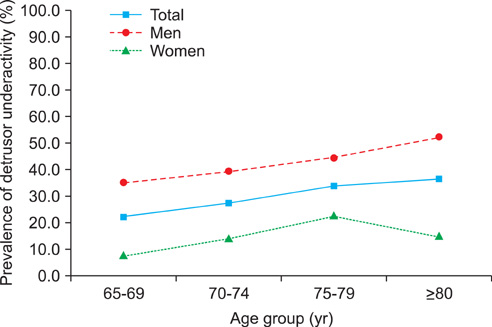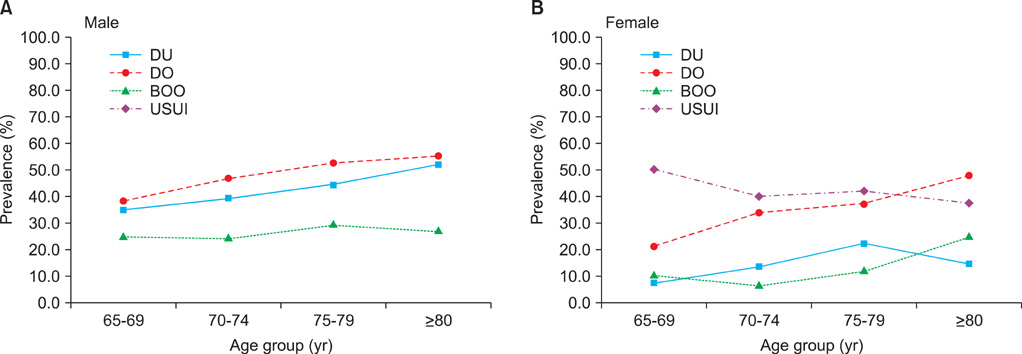Korean J Urol.
2012 May;53(5):342-348.
Prevalence and Clinical Features of Detrusor Underactivity among Elderly with Lower Urinary Tract Symptoms: A Comparison between Men and Women
- Affiliations
-
- 1Department of Urology, Seoul National University Bundang Hospital, Seongnam, Korea. urojsj@yahoo.co.kr
Abstract
- PURPOSE
To identify the prevalence and clinical features of detrusor underactivity (DU) in elderly men and women presenting with lower urinary tract symptoms (LUTS).
MATERIALS AND METHODS
We reviewed 1,179 patients aged over 65 years who had undergone a urodynamic study for LUTS with no neurological or anatomical conditions. DU was defined as a bladder contractility index <100 and a maximal flow rate (Qmax) < or =12 ml/s combined with a detrusor pressure at Qmax < or =10 cmH2O for men and women, respectively.
RESULTS
Of the patients, 40.2% of men and 13.3% of women were classified as having DU (p<0.001). Types of clinical symptoms were not significantly different between patients with and without DU. In men, whereas the prevalence of bladder outlet obstruction (BOO) was constant across the age spectrum, the prevalence of DU and detrusor overactivity (DO) increased with age, and 46.5% of men with DU also had DO or BOO. In women, the prevalence of DU also increased with age, and the trend was more remarkable in women aged over 70 years. DU was accompanied by DO or urodynamic stress urinary incontinence (USUI) in 72.6% of the women with DU. Women with DU were found to have lower cystometric capacity and exhibited a greater incidence of reduced compliance than did women without DU.
CONCLUSIONS
DU was a common mechanism underlying LUTS in the elderly population, especially in men. One half of the men and three quarters of the women with DU also had other pathologies such as DO, BOO, or USUI.
Keyword
MeSH Terms
Figure
Reference
-
1. United Nations Population Division. World Population Ageing 1950-2050. 2001. New York: United Nations Publications.2. 2006 Statistics on the aged. Statistics Korea [Internet]. c2012. Cited 2011 Jul 1. Daejeon: Statistics Korea;Available from: http://kostat.go.kr/portal/english/news/1/8/index.board?bmode=read&bSeq=&aSeq=67162&pageNo=3&rowNum=10&navCount=10&currPg=&sTarget=title&sTxt=2006.3. Koskimaki J, Hakama M, Huhtala H, Tammela TL. Prevalence of lower urinary tract symptoms in Finnish men: a population-based study. Br J Urol. 1998. 81:364–369.4. Managing acute and chronic urinary incontinence. U.S. Department of Health and human services. J Am Acad Nurse Pract. 1996. 8:390–403.5. Brown JS, Vittinghoff E, Wyman JF, Stone KL, Nevitt MC, Ensrud KE, et al. Urinary incontinence: does it increase risk for falls and fractures? Study of Osteoporotic Fractures Research Group. J Am Geriatr Soc. 2000. 48:721–725.6. Hu TW, Wagner TH, Bentkover JD, LeBlanc K, Piancentini A, Stewart WF, et al. Estimated economic costs of overactive bladder in the United States. Urology. 2003. 61:1123–1128.7. Abrams P, Cardozo L, Fall M, Griffiths D, Rosier P, Ulmsten U, et al. The standardisation of terminology in lower urinary tract function: report from the standardisation sub-committee of the International Continence Society. Urology. 2003. 61:37–49.8. Resnick NM, Yalla SV, Laurino E. The pathophysiology of urinary incontinence among institutionalized elderly persons. N Engl J Med. 1989. 320:1–7.9. Seki N, Kai N, Seguchi H, Takei M, Yamaguchi A, Naito S. Predictives regarding outcome after transurethral resection for prostatic adenoma associated with detrusor underactivity. Urology. 2006. 67:306–310.10. Gateau T, Faramarzi-Roques R, Le Normand L, Glemain P, Buzelin JM, Ballanger P. Clinical and urodynamic repercussions after TVT procedure and how to diminish patient complaints. Eur Urol. 2003. 44:372–376.11. Valentini FA, Robain G, Marti BG, Nelson PP. Urodynamics in a community-dwelling population of females 80 years or older. Which motive? Which diagnosis? Int Braz J Urol. 2010. 36:218–224.12. Abarbanel J, Marcus EL. Impaired detrusor contractility in community-dwelling elderly presenting with lower urinary tract symptoms. Urology. 2007. 69:436–440.13. Groutz A, Gordon D, Lessing JB, Wolman I, Jaffa A, David MP. Prevalence and characteristics of voiding difficulties in women: are subjective symptoms substantiated by objective urodynamic data? Urology. 1999. 54:268–272.14. Ameda K, Sullivan MP, Bae RJ, Yalla SV. Urodynamic characterization of nonobstructive voiding dysfunction in symptomatic elderly men. J Urol. 1999. 162:142–146.15. Taylor JA 3rd, Kuchel GA. Detrusor underactivity: Clinical features and pathogenesis of an underdiagnosed geriatric condition. J Am Geriatr Soc. 2006. 54:1920–1932.16. Coyne KS, Tubaro A, Brubaker L, Bavendam T. Development and validation of patient-reported outcomes measures for overactive bladder: a review of concepts. Urology. 2006. 68:2 Suppl. 9–16.17. Schafer W, Abrams P, Liao L, Mattiasson A, Pesce F, Spangberg A, et al. Good urodynamic practices: uroflowmetry, filling cystometry, and pressure-flow studies. Neurourol Urodyn. 2002. 21:261–274.18. Abrams P. Bladder outlet obstruction index, bladder contractility index and bladder voiding efficiency: three simple indices to define bladder voiding function. BJU Int. 1999. 84:14–15.19. Tubaro A, La Vecchia C. Uroscreening Study Group. The relation of lower urinary tract symptoms with life-style factors and objective measures of benign prostatic enlargement and obstruction: an Italian survey. Eur Urol. 2004. 45:767–772.20. Gotoh M, Yoshikawa Y, Ohshima S. Pathophysiology and subjective symptoms in women with impaired bladder emptying. Int J Urol. 2006. 13:1053–1057.21. Defreitas GA, Zimmern PE, Lemack GE, Shariat SF. Refining diagnosis of anatomic female bladder outlet obstruction: comparison of pressure-flow study parameters in clinically obstructed women with those of normal controls. Urology. 2004. 64:675–679.22. Hotta H, Morrison JF, Sato A, Uchida S. The effects of aging on the rat bladder and its innervation. Jpn J Physiol. 1995. 45:823–836.23. Sibley GN. The physiological response of the detrusor muscle to experimental bladder outflow obstruction in the pig. Br J Urol. 1987. 60:332–336.24. Belenky A, Abarbanel Y, Cohen M, Yossepowitch O, Livne PM, Bachar GN. Detrusor resistive index evaluated by Doppler ultrasonography as a potential indicator of bladder outlet obstruction. Urology. 2003. 62:647–650.25. Bromage SJ, Dorkin TJ, Chan L, Tse V. Urodynamics in the octogenarian female: is it worthwhile? Int Urogynecol J. 2010. 21:1117–1121.26. Griffiths D, Hofner K, van Mastrigt R, Rollema HJ, Spangberg A, Gleason D. Standardization of terminology of lower urinary tract function: pressure-flow studies of voiding, urethral resistance, and urethral obstruction. International Continence Society Subcommittee on Standardization of Terminology of Pressure-Flow Studies. Neurourol Urodyn. 1997. 16:1–18.27. Blaivas JG, Groutz A. Bladder outlet obstruction nomogram for women with lower urinary tract symptomatology. Neurourol Urodyn. 2000. 19:553–564.28. Akikwala TV, Fleischman N, Nitti VW. Comparison of diagnostic criteria for female bladder outlet obstruction. J Urol. 2006. 176:2093–2097.29. van Koeveringe GA, Rahnama'i MS, Berghmans BC. The additional value of ambulatory urodynamic measurements compared with conventional urodynamic measurements. BJU Int. 2010. 105:508–513.
- Full Text Links
- Actions
-
Cited
- CITED
-
- Close
- Share
- Similar articles
-
- Pathophysiology of lower urinary tract dysfunction in the older patient
- Urodynamic Analysis of Old-aged Men with Persistent Lower Urinary Tract Symptoms after Medical Treatments
- How do we diagnose detrusor underactivity? Comparison of diagnostic criteria based on an urodynamic measure
- Geriatric considerations in the diagnosis and management of lower urinary tract dysfunction
- Prevalence and urodynamic characteristics of detrusor overactivity with impaired contractility in the community-dwelling elderly with non-neurogenic lower urinary tract symptoms: Is it from a single or two independent bladder dysfunctions?




